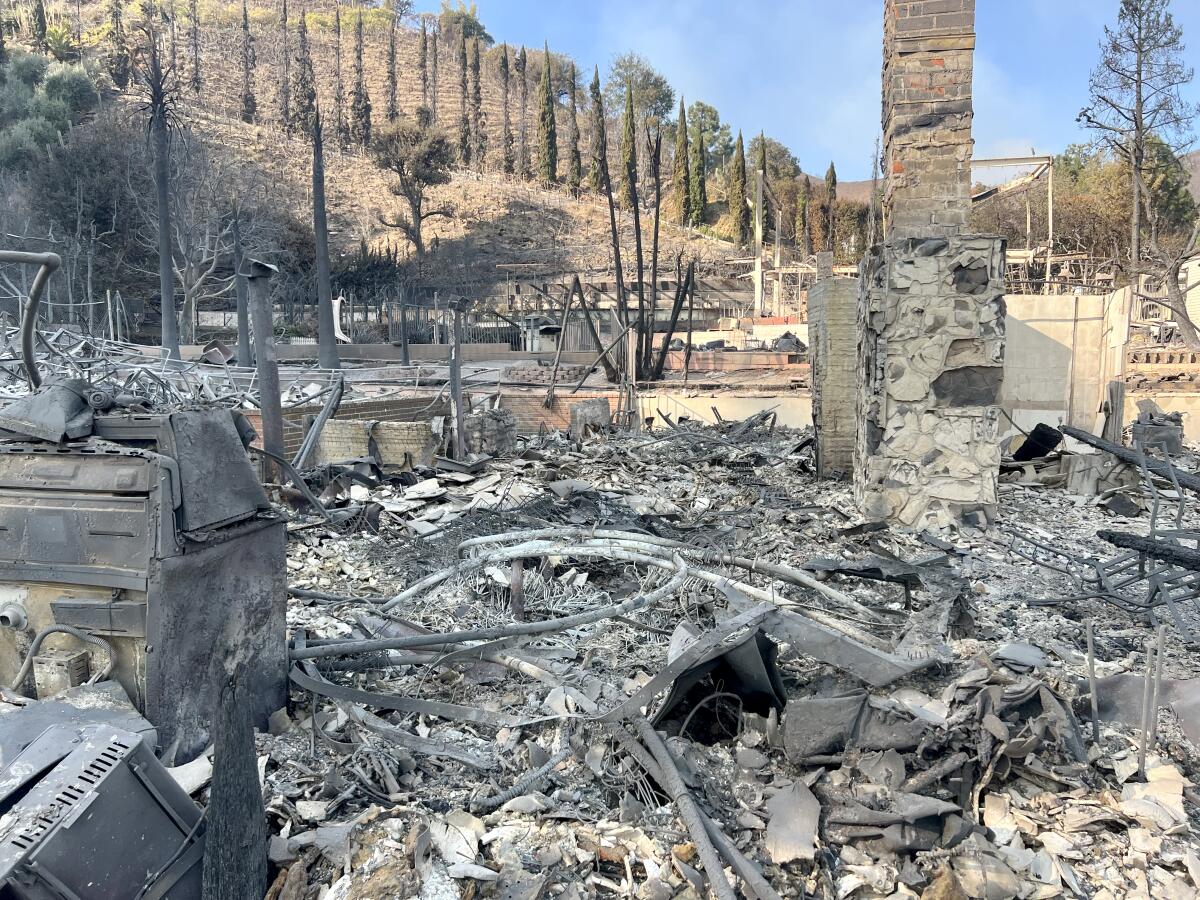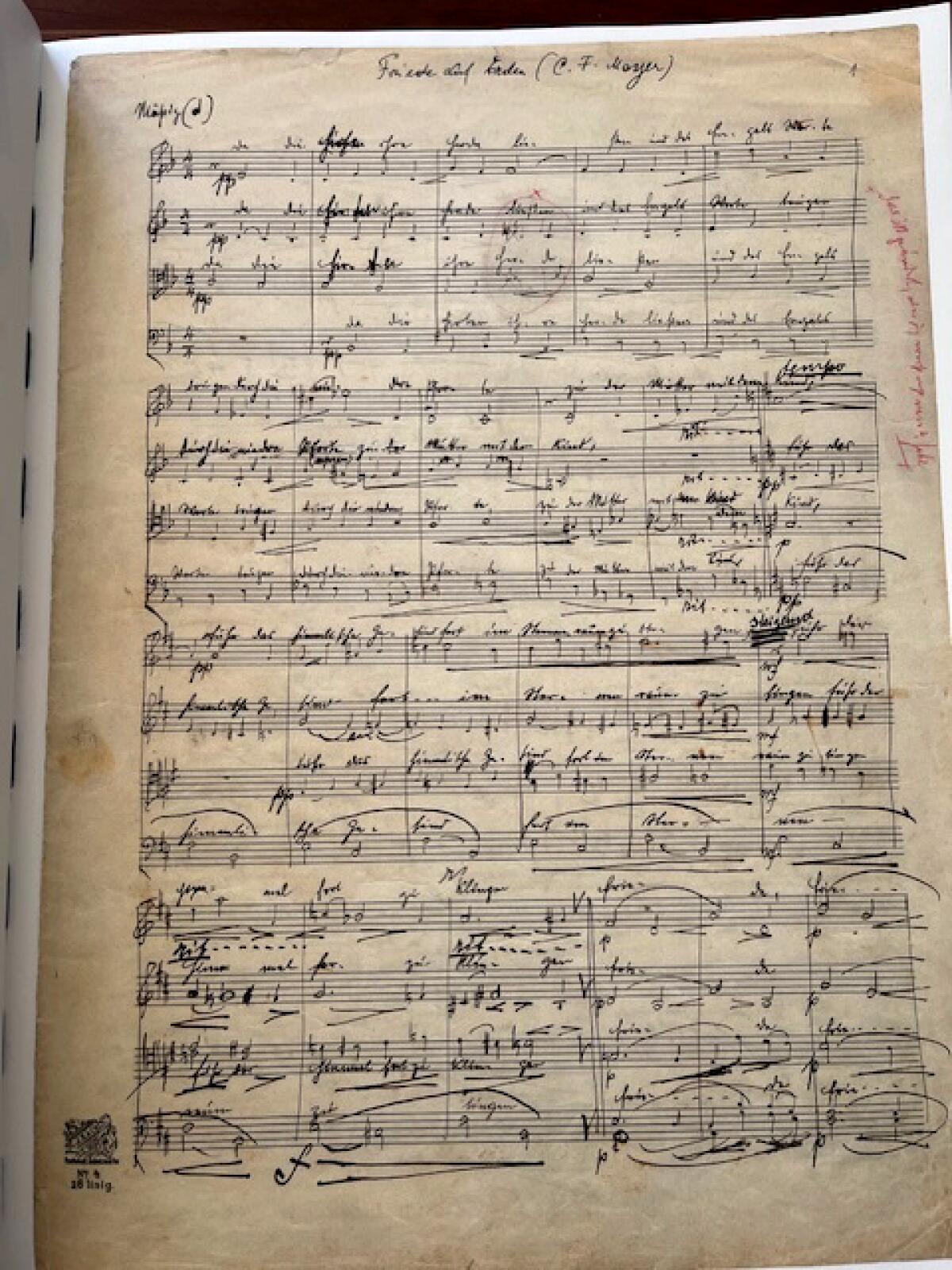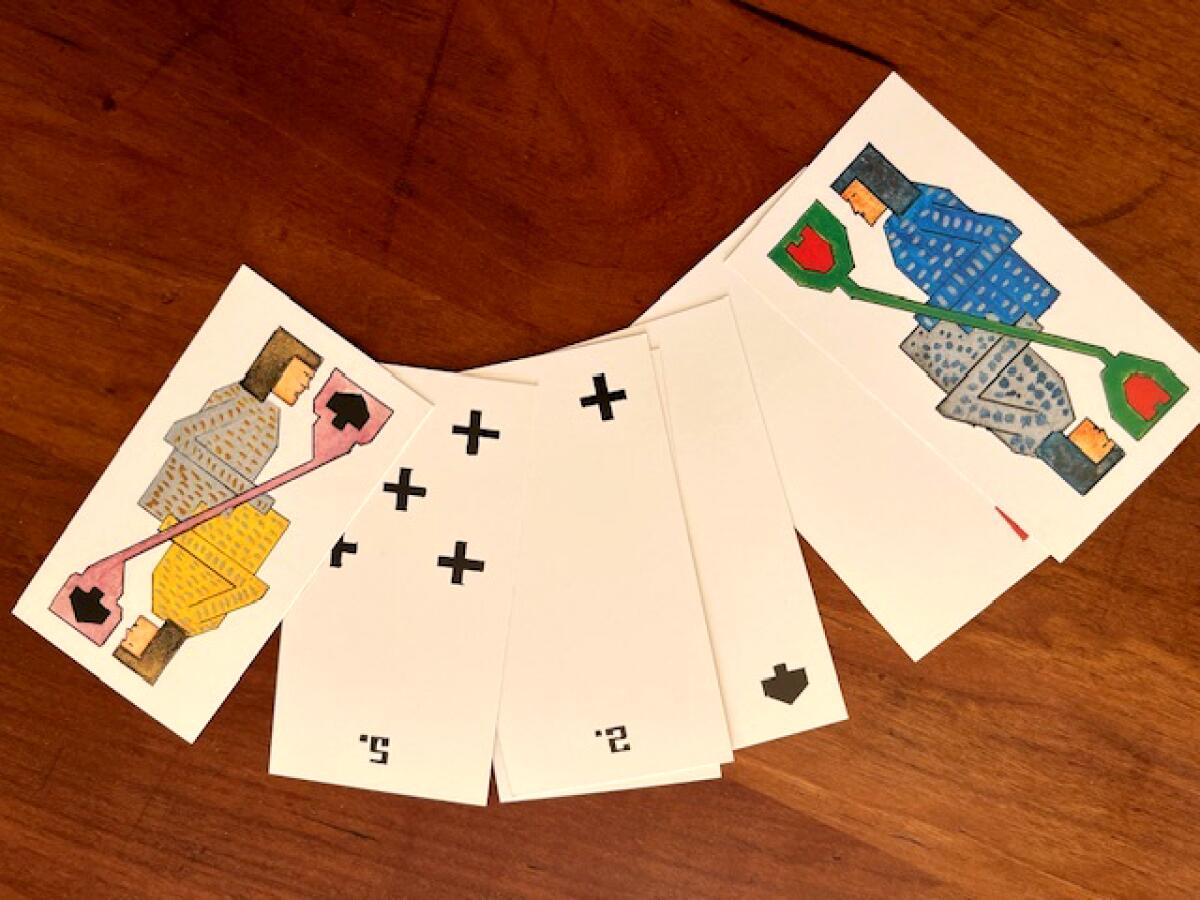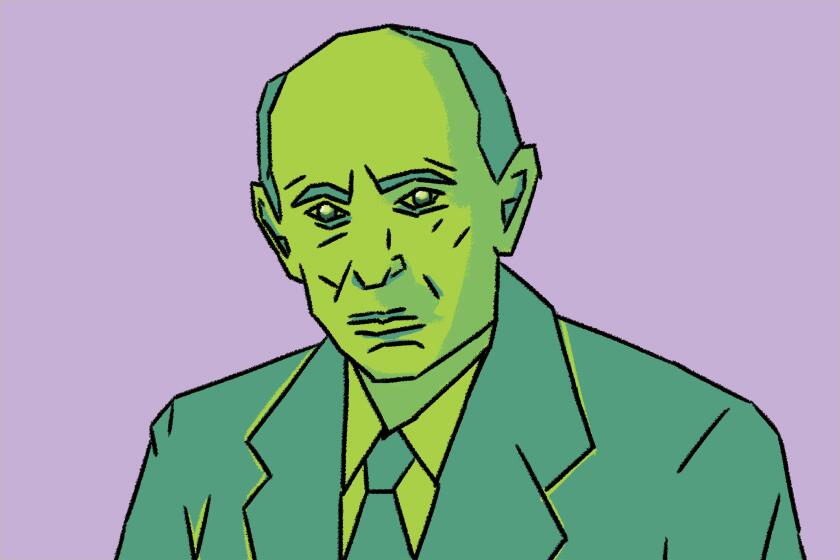A treasure house of composer Arnold Schoenberg’s music destroyed in Palisades fire

- Share via
- Schoenberg helped shape modern music worldwide, but he also had a profound and still-present influence on the cultural life of Los Angeles.
On the morning of Jan. 7, Larry Schoenberg was about to prepare the tax filings for Belmont Music Publishers, the august house dedicated to preserving and promoting the works of his late father, Arnold Schoenberg, one of the most influential musicians of the 20th century, when his daughter Camille called and told him to look outside.
“Oh my God,” he said. Thick plumes of smoke were whipping up all around his Pacific Palisades home. Without thinking he jumped into his car, his wife in the other, and they drove to their daughter’s house elsewhere in the Palisades.
The plan was to wait it out. However, before the day was over, Schoenberg’s house was gone. Eventually, the flames reached his daughter’s house, and they fled to Venice to stay with another daughter.
The inferno also blasted to ash Belmont Music Publishers, which was housed in a building behind his home on Bienveneda Avenue. For 60 years, Belmont served as a bridge between Schoenberg — often referred to as the man who invented “modern music” — and performers and scholars, providing access to his music.

While the majority of the composer’s original works remain housed at the Arnold Schönberg Center in Vienna, Belmont’s entire physical inventory, upwards of 100,000 items including manuscripts and original scores, along with correspondence, books, photographs and artworks, had all perished.
For Larry Schoenberg, it wasn’t merely the physical loss, but “a profound cultural blow” — yet another example of how the wildfires have destroyed a trove of L.A.’s cultural heritage.
The Palisades and Eaton fires destroyed or damaged several locations that have been used to make movies and TV shows.
Schoenberg revolutionized Western compositional techniques and helped shape modern music worldwide, but he also had a profound and still-present influence on the cultural life of Los Angeles.
“The scale of this fire makes it hard to handle how big the losses are,” said Joy H. Calico, chair of the Department of Musicology at UCLA’s Herb Alpert School of Music. “It’s not as if his entire legacy was lost but certainly in terms of the practical reality of performing his music, this is a serious blow.”
***
Schoenberg’s wife, Gertrud, a librettist, and son Larry established Belmont Music Publishers in 1965. Belmont was a play on the family’s surname — “beautiful mountain” — in German.
Following the composer’s death in 1951, numerous people wrote to Gertrud requesting his music. There was so much back-and-forthing with the publisher in Germany that his heirs decided to create Belmont, as Gertrud owned the rights to her husband’s catalog. They initially set up the business in a converted garage behind their Brentwood home, selling and renting curated editions of Schoenberg’s sheet music for performances.
“We’re not very business savvy people,” Larry Schoenberg recalled. “We were spending more than we were collecting.”
They also had to overcome the negative connotation business had in their home. “We grew up where business was kind of a dirty word,” he said. His father used the derisive German term “der Gauner,” which means crook or swindler.
But Belmont, which later moved to the building behind Larry Schoenberg’s Pacific Palisades house, became a business successful in preserving Schoenberg’s legacy, making his works accessible to the world.
Last September marked the 150th anniversary of Schoenberg’s birth. A flurry of performances took place in Europe and the United States, including by the San Francisco Symphony and the Los Angeles Philharmonic. Many of these performances got their scores from Belmont.

At 83, Larry Schoenberg, a former math teacher at Palisades High School, has been Belmont’s steadfast guardian.
He maintained a whiteboard with all of the upcoming performances of his father’s music and what needed to be shipped. Everything was well labeled and organized, but nothing was digitized.
“This is just my stupidity,” he said. “Everything was backed up, except it was backed up locally. I had hard drives and thumb drives. I didn’t use the cloud, I was a little bit worried about using the cloud. Well, of course, now I wish I had everything in the cloud. What that means is essentially we have nothing.”
The fire claimed the full range of Schoenberg’s groundbreaking compositions held there, from early Romantic pieces to his revolutionary 12-tone works and transformative masterpieces like “Pierrot Lunaire.” Also lost were performance posters, a bust of Schoenberg and ephemera such as the fanciful playing card sets the composer designed.
Also gone was the irreplaceable library filled with 50 years worth of manuscripts and correspondence from conductors, such as Zubin Mehta and Claudio Abbado, who performed Schoenberg.
“When the conductors return the scores, they put a lot of information in there. That’s really crucial for performances,” said Larry Schoenberg. “And that’s all gone. The correspondence goes back to the ’70s. In fact, every once in a while I look at some of this correspondence.”
Last December, Larry shipped a box of 16 books to his nephew E. Randol Schoenberg. They are all that remains from Belmont’s library.
Reflecting on all that was lost, he said, “The memories are still there. I didn’t lose those yet.”

***
Arnold Schoenberg was already a towering intellectual and cultural figure when he landed in Los Angeles in 1934.
Born in Vienna in 1874, the composer also was a writer, teacher, inventor and painter.
Uncompromising and innovative, he devised the 12-tone method, a musical structure that broke with the traditional rules of tonality and composition. Although it prompted (and still does) enormous debate, it was also considered by many the future of music. The Nazis, however, labeled his music “degenerate.”

In 1933, after receiving a telegram from his brother-in-law, the violinist Rudolf Kolisch, saying “a change of air is recommended,” the composer, then 60, and his family fled Berlin on the midnight train to Paris, leaving everything behind, according to his grandson E. Randol Schoenberg, known as Randy.
Schoenberg spent a brief time in Boston and New York, before fleeing the harsh East Coast winters for Los Angeles. “It is Switzerland, the Riviera, the Vienna Woods, the desert, Salzkammergut, Spain, Italy — everything in one place. And along with that scarcely a day, apparently even in winter, without sun,” he wrote Anton Webern, the Austrian composer and conductor.
His arrival was part of the exodus of German-speaking Jews who emigrated from Nazi-occupied Europe that helped usher in a golden age of classical music in Los Angeles, with many writing film scores.

In 1936 Schoenberg bought a Spanish Colonial in Brentwood, and the house became a center of cultural life for European exiles, entertaining the likes of Thomas Mann and Franz Werfel and his wife, Alma Mahler-Werfel.
There, Schoenberg befriended Hollywood luminaries. Shirley Temple was a neighbor, and Harpo Marx was a friend, as was George Gershwin, who was also his tennis partner. According to Randy, his grandfather was playing a match with Gershwin when his wife gave birth to Randy’s father, Ronald, in 1937.
Schoenberg, who taught at UCLA, had a reputation as a gifted teacher whose tutelage held cachet. When the German conductor Otto Klemperer came to the city to perform at the Los Angeles Philharmonic, he studied with Schoenberg.
With finances tight, he took on private students, a great deal of them composers who had come to California to work for the movie studios. “They wanted to learn what sort of tricks and techniques, you know, how do I make my music sound like this?” Randy said. “They would come for a couple lessons and then put it on their resume, ‘studies with Arnold Schoenberg,’ and never come back.
“He got wise to this and decided to charge a lot for the initial lessons. And if the person turned into a real student, he would reduce the rates.”

Several of Schoenberg’s “real” students, such as John Cage, Alfred Newman and David Raksin, became hugely successful, and their relationships helped to perpetuate the composer’s lasting influence in Hollywood and beyond.
Posthumously, Schoenberg’s impact is undeniable.
Film composers have long used his pioneering 12-tone technique to produce dissonance and unpredictable melodies, such as Jerry Goldsmith, in his benchmark score in the 1968 film “Planet of the Apes.”
While Schoenberg’s music continues to be played all over the world, his notes are all over Los Angeles.
The music building and main concert venue at UCLA are named after Schoenberg. In May the opera “Schoenberg in Hollywood” will be performed at UCLA. It presents three imagined vignettes from the composer’s life.
Arnold Schoenberg’s sacrilegious “Pierrot Lunaire” foretold a distortion of reality that has never left us.
His heirs who have diligently tended his legacy have also been important civic and cultural figures in the life of this city. In addition to his son Larry, Ronald is a retired judge. He lives with his wife, Barbara, the daughter of the composer Eric Zeisl, in Schoenberg’s original Brentwood home. Their son Randy, a lawyer, won a significant case before the Supreme Court in 2004, leading to the government of Austria returning five Gustav Klimt paintings stolen by the Nazis to the family of Maria Altman.
The Schoenberg family, four members of which have lost homes in the fires, say they hope to create digitized scores from the manuscripts kept in Vienna as well to recreate other documents and correspondence that exists in the hands of others around the world. Larry Schoenberg said they’ve received a wellspring of support and encouragement from all over the world.
“It’s astounding to think about how that legacy was moved out of central Europe because of the peril there — only to find it facing a different crisis here,” Calico said.
More to Read
Inside the business of entertainment
The Wide Shot brings you news, analysis and insights on everything from streaming wars to production — and what it all means for the future.
You may occasionally receive promotional content from the Los Angeles Times.












